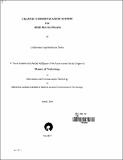Chaotic communication system for IEEE 802.11b (WLAN)
Abstract
Today's WLAN (IEEE 802.11b) is most attractive solution for wireless data communication at higher rate. Chaotic signals, by virtue of their wideband characteristic, are natural candidates for wideband communication environment. The use of chaotic signals in communication thus naturally inhabits the advantages offered by conventional spread spectrum communication system.
A novel Chaotic Code Division Multiple Access (CCDMA) scheme is proposed for IEEE 802.11b Physical layer implementation based Direct Spread Spectrum Technique. The work carried out in this thesis consists of investigation of efficient chaos based architecture for IEEE802.11b (WLAN) to support more number of users. Characteristic of various chaotic signal are studied, results in robust multi user chaotic systems, which are characterized by sensitive dependence on initial conditions, random noise like behaviour, and continuous broadband power spectrum. The properties of chaotic signals comprise the requirements for the signals applied in broadband communication systems, particular for spread-spectrum, multi-user and secure communications.
Simulation results of proposed model open up a new improved architecture with effective Bit error rate performance in multiuser. This simulation is done in A WGN environment. The simulation is carried out as per the specification of IEEE 802.11b standard.
Collections
- M Tech Dissertations [923]
Related items
Showing items related by title, author, creator and subject.
-
Channel quality prediction and localization
Patel, Animesh (Dhirubhai Ambani Institute of Information and Communication Technology, 2007)In this thesis we focus on two problems, Channel Quality Prediction and Localization in wireless network. In High-Speed Downlink Packet Access (HSDPA) architecture of Universal Mobile Telecommunications Services (UMTS), ... -
Optical wireless sensor network design for a conducting chamber
Borkar, Abhishek (Dhirubhai Ambani Institute of Information and Communication Technology, 2011)Now a day’s majority of the wireless sensor networks (WSNs) are based on Radio Frequency (RF) communication technology. But RF when used in an environment like that of metallic, conducting chamber exhibits large amount of ... -
Game theory based strategies for cooperation in ad hoc wireless networks
Rajput, Nitin Singh (Dhirubhai Ambani Institute of Information and Communication Technology, 2010)In self-organized ad-hoc wireless networks, nodes belong to different authorities, pursue different goals, have constrains like energy; therefore, cooperation among them cannot be taken for granted. Non cooperation of nodes ...

